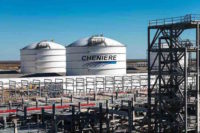As multibillion dollar liquefied natural gas plants continue to be built to export the United States’ plentiful supply of cheap natural gas, a less noticeable trend is occurring benefiting domestic LNG customers: the construction of small LNG facilities.
The Pipeline and Hazardous Materials Safety Administration, which regulates domestic LNG facilities, reports that the number of domestic LNG facilities has grown to 157 in 2018 from 122 in 2010, with storage volume growing to 55.7 million barrels in 2018 from 45.4 million barrels in 2010.
The number of those terminals could increase if, as proposed by the Trump administration, LNG is allowed to be shipped by rail. Comments on that controversial proposal, to allow the flammable substance to be moved by rail for the first time, are due Dec. 23.
The facilities are used by electric utilities as “peak shavers” that can supply natural gas to a power plant when cold weather limits the availability of natural gas from pipelines and increases its price. The smaller LNG facilities are also used to fuel industrial sites and ships.
“We have seen in last four or five years a lot of projects to improve the reliability of existing sites, especially with polar vortexes–a lot of gas-fired generation has gone without fuel during the really cold peaks,” says Tisha Scroggin-Wicker a business manager at Burns & McDonnell. Most of those projects are in the Midwest or the Northeast, where cold weather impacts natural gas deliveries, or where there are fewer pipelines.
The facilities have been around for decades, and are typically used only three to eight days in a single year. But during that time, they can pay for themselves because the owners have taken natural gas off the pipeline system when the prices are low, converted it to LNG and stored it. When prices skyrocket because of high demand or low supply, the owner has natural gas at a fraction of the normal price.
“It’s a backup insurance policy,” says Laura Musick, project development manager at Black & Veatch.
The facilities are also becoming popular as pipelines have become more difficult to build. An LNG facility can be built near a pipeline, and utilities and industries can move the LNG to a facility by truck.
Small LNG facilities can also be used to fuel generation in a microgrid at a place like a hospital or college campus in case of an emergency.
“It’s one of the things we see that is starting to make sense,” Scroggin-Wicker says of using small LNG facilities to provide power to a microgrid.
Small LNG facilities require a place to receive the fuel, storage in varying amounts and a unit to turn the super-chilled LNG back into vapor.








